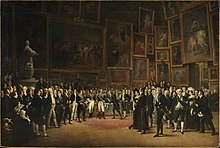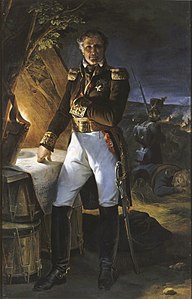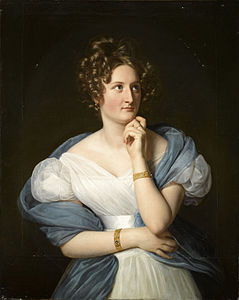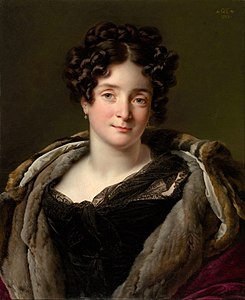| Revision as of 02:12, 22 December 2024 editCitation bot (talk | contribs)Bots5,445,368 edits Added title. Changed bare reference to CS1/2. | Use this bot. Report bugs. | Suggested by BorgQueen | Linked from User:AlexNewArtBot/GoodSearchResult | #UCB_webform_linked 468/1386← Previous edit | Latest revision as of 03:42, 23 December 2024 edit undoCitrusHemlock (talk | contribs)Extended confirmed users1,246 edits added Category:Salon de peinture et de sculpture using HotCat | ||
| (2 intermediate revisions by 2 users not shown) | |||
| Line 5: | Line 5: | ||
| ==Exhibition== | ==Exhibition== | ||
| ]'' by ]]] | ]'' by ]]] | ||
| Amongst French painters there was anticipation over the return of ] who had drawn interest at the ]. When two of his paintings had been rejected by the committee for the 1822 Salon, he had responded by withdrawing all his entries bar one and went on to hold a private exhibition in his own studios which was a great success.<ref>Harkett & Hornstein p.40-42</ref> In 1824 he exhibited more than twenty paintings, including older works that functioned as a ].<ref>Harkett & Hornstein p.92</ref> | Amongst French painters there was anticipation over the return of ] who had drawn interest at the ]. When two of his paintings had been rejected by the committee for the ], he had responded by withdrawing all his entries bar one and went on to hold a private exhibition in his own studios which was a great success.<ref>Harkett & Hornstein p.40-42</ref> In 1824 he exhibited more than twenty paintings, including older works that functioned as a ].<ref>Harkett & Hornstein p.92</ref> | ||
| Amongst paintings displayed were ]'s '']'' depicting a scene from the ]. Notable portraits included ] by ] and the ] by Vernet. Several of Vernet's large ]s were also exhibited including '']'' and ], as well as his ] '']''. ] included ''Psyché'' by ] and ''Dying Eurydice'' by ]. Touching on more recent events '']'' by ] portrayed the aftermath of the assassination of the ], the son of Charles X, in 1820.<ref>{{cite web | url=https://collections.chateauversailles.fr/#/query/478dd3e6-6afb-4300-b969-887ac3aca38b | title=CollectionConnection }}</ref> | Amongst paintings displayed were ]'s '']'' depicting a scene from the ]. Notable portraits included ] by ] and the ] by Vernet. Several of Vernet's large ]s were also exhibited including '']'' and ], as well as his ] '']''. ] included ''Psyché'' by ] and ''Dying Eurydice'' by ]. Touching on more recent events '']'' by ] portrayed the aftermath of the assassination of the ], the son of Charles X, in 1820.<ref>{{cite web | url=https://collections.chateauversailles.fr/#/query/478dd3e6-6afb-4300-b969-887ac3aca38b | title=CollectionConnection }}</ref> | ||
| The Salon featured a sharp contrast between ] and ] typified by ]'s '']'' depicting a scene from the ] and '']'' by ]. This growing rivalry continued continued into the next ].<ref>Gildea p.185</ref> | The Salon featured a sharp contrast between ] and ] typified by ]'s '']'' depicting a scene from the ] and '']'' by ]. This growing rivalry continued continued into the next ].<ref>Gildea p.185</ref> | ||
| Many of the officials, sculptors and painters involved in the 1824 Salon were featured in ]'s 1827 painting ].<ref>Mansel p.94</ref> | Many of the officials, sculptors and painters involved in the 1824 Salon were featured in ]'s 1827 painting ].<ref>Mansel p.94</ref> | ||
| Line 62: | Line 62: | ||
| ] | ] | ||
| ] | ] | ||
| ] | |||
Latest revision as of 03:42, 23 December 2024
1824 art exhibition in Paris
The Salon of 1824 was an art exhibition held at the Louvre in Paris between 25 August 1824 and 15 January 1825. It took place during the Restoration Era that followed the downfall of Napoleon's French Empire. At the time one of Europe's premier art exhibitions, the Salon was held roughly biennaly during the period. It was the first to be held since Charles X succeeded to the throne earlier the same year.
Exhibition

Amongst French painters there was anticipation over the return of Horace Vernet who had drawn interest at the Salon of 1819. When two of his paintings had been rejected by the committee for the 1822 Salon, he had responded by withdrawing all his entries bar one and went on to hold a private exhibition in his own studios which was a great success. In 1824 he exhibited more than twenty paintings, including older works that functioned as a retrospective.
Amongst paintings displayed were Paul Delaroche's Joan of Arc, Sick, Interrogated in Prison by the Cardinal of Winchester depicting a scene from the Medieval era. Notable portraits included Portrait of Madame Reiset by Girodet and the Portrait of Marshal Saint-Cyr by Vernet. Several of Vernet's large battle scenes were also exhibited including The Battle of Hanau and The Battle of Montmirail, as well as his genre painting Duck Shooting. Sculptures included Psyché by James Pradier and Dying Eurydice by Charles-François Leboeuf. Touching on more recent events The Death of the Duke of Berry by Alexandre Menjaud portrayed the aftermath of the assassination of the Duke of Berry, the son of Charles X, in 1820.
The Salon featured a sharp contrast between neoclassical and romantic art typified by Eugène Delacroix's The Massacre at Chios depicting a scene from the Greek War of Independence and The Vow of Louis XIII by Jean-Auguste-Dominique Ingres. This growing rivalry continued continued into the next Salon in 1827.
Many of the officials, sculptors and painters involved in the 1824 Salon were featured in François Joseph Heim's 1827 painting Charles X Distributing Awards to Artists.
British Salon

For the first time several leading British artists exhibited at the Salon, although J. M. W. Turner was notably absent. Although the British contingent was small, it had a disproportionate influence on reporting of the exhibition. The President of the Royal Academy Sir Thomas Lawrence sent a copy of his Portrait of the Duke of Richelieu featuring a recent French Prime Minister. Richard Parkes Bonington a young Anglo-French artist exhibited five landscapes and was awarded a gold medal. Copley Fielding was also awarded one for his watercolors.
Most notably John Constable, a comparatively unsuccessful British artist was hailed for his entries, particularly The Hay Wain which featured a landscape painting of the River Stour in his native Suffolk.The French government unsuccessfully attempted to acquire it for the Louvre, but it is now in the collection of the National Gallery in London.
At the subsequent Salon of 1827 the British participation was larger and included Lawrence's The Red Boy and Constable's The Cornfield.
Gallery
-
 A Fishmarket near Boulogne by Richard Parkes Bonington
A Fishmarket near Boulogne by Richard Parkes Bonington
-
 French Coast with Fisherman by Richard Parkes Bonington
French Coast with Fisherman by Richard Parkes Bonington
-
 Portrait of the Marquis de Bonchamps by Anne-Louis Girodet
Portrait of the Marquis de Bonchamps by Anne-Louis Girodet
-
 Portrait of Jacques Cathelineau by Anne-Louis Girodet
Portrait of Jacques Cathelineau by Anne-Louis Girodet
-
 The Vow of Louis XIII by Jean-Auguste-Dominique Ingres
The Vow of Louis XIII by Jean-Auguste-Dominique Ingres
-
 Joan of Arc Interrogated by the Cardinal of Winchester by Paul Delaroche
Joan of Arc Interrogated by the Cardinal of Winchester by Paul Delaroche
-
 Dying Eurydice by Charles-François Leboeuf
Dying Eurydice by Charles-François Leboeuf
-
 The Death of the Duke of Berry by Alexandre Menjaud
The Death of the Duke of Berry by Alexandre Menjaud
-
 The Dauphin's Entry Into Paris by Jean-Auguste-Dominique Ingres
The Dauphin's Entry Into Paris by Jean-Auguste-Dominique Ingres
-
 The Capture of Pamplona by Carle Vernet
The Capture of Pamplona by Carle Vernet
-
 Allan M'Aulay by Horace Vernet
Allan M'Aulay by Horace Vernet
-
 The Battle of Hanau by Horace Vernet
The Battle of Hanau by Horace Vernet
-
 The Battle of Montmirail by Horace Vernet
The Battle of Montmirail by Horace Vernet
-
 Duck Shooting by Horace Vernet
Duck Shooting by Horace Vernet
-
 Portrait of Marshal Saint-Cyr by Horace Vernet
Portrait of Marshal Saint-Cyr by Horace Vernet
-
 Psyché by James Pradier
Psyché by James Pradier
-
 Portrait of the Duchess of Berry by Élisabeth Vigée Le Brun
Portrait of the Duchess of Berry by Élisabeth Vigée Le Brun
-
 Portrait of the Duke of Richelieu by Thomas Lawrence
Portrait of the Duke of Richelieu by Thomas Lawrence
-
 Yarmouth Jetty by John Constable
Yarmouth Jetty by John Constable
-
 Portrait of Delphine de Girardin by Louis Hersent
Portrait of Delphine de Girardin by Louis Hersent
-
 Portrait of Madame Reizet by Anne-Louis Girodet-Trioson
Portrait of Madame Reizet by Anne-Louis Girodet-Trioson
References
- Harkett & Hornstein p.204
- Harkett & Hornstein p.40-42
- Harkett & Hornstein p.92
- "CollectionConnection".
- Gildea p.185
- Mansel p.94
- Wolohojian & Tahinci p.354
- May p.136
- Charles 152
- Johnson p.614
Bibliography
- Charles, Victoria. Constable. Parkstone International, 2015.
- Gildea, Robert. Children of the Revolution: The French, 1799-1914. Harvard University Press, 2008.
- Harkett, Daniel & Hornstein, Katie (ed.) Horace Vernet and the Thresholds of Nineteenth-Century Visual Culture. Dartmouth College Press, 2017.
- Johnson, Paul. The Birth Of The Modern: World Society 1815-1830. Orion, 2013.
- Mansel, Philip. Dressed to Rule: Royal and Court Costume from Louis XIV to Elizabeth II. Yale University Press, 2005.
- May, Stephen J. Voyage of The Slave Ship: J.M.W. Turner's Masterpiece in Historical Context. McFarland, 2014
- Noon, Patrick & Bann, Stephen. Constable to Delacroix: British Art and the French Romantics. Tate, 2003.
- Wolohojian, Stephan & Tahinci, Anna. A Private Passion: 19th-century Paintings and Drawings from the Grenville L. Winthop Collection, Harvard University. Metropolitan Museum of Art, 2003.